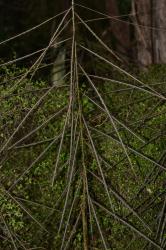- Taxon
- Gallery
- ≡ Aralia crassifolia Sol. ex A.Cunn., Ann. Nat. Hist. 2: 214 (1839)
- ≡ Panax crassifolius (Sol. ex A.Cunn.) Decne. & Planch., Ser. IV. iii: 105 (1854) – as crassifolium
- = Pseudopanax crassifolius var. trifoliolatum Kirk
- = Hedera crassifolia A.Gray, U.S. Explor. Exped., Phan. 719 (1854)
- = Panax coriaceus Regel, Gartenflora 45 (1859) – as coriaceum
- = Panax longissimus Hook.f., Handb. New Zealand Fl. 102 (1864) – as longissimum
Tree up to 15 m. tall, trunk up to c. 5 dm. diam., lvs very thick and rigid. Seedlings with submembr. ovate to lanceolate deeply toothed lvs, deeply lobed near base, passing rapidly into narrow-linear lvs. Unbranched juveniles with narrow-linear deflexed lvs up to 1 m. or more long, distantly sharply toothed, with stout midrib. At branching stage the lvs become shorter, c. 30–15 cm. long, and may be unifoliolate (var. unifoliolatum Kirk For. Fl. 1889, 61) or 3–5-foliolate (var. trifoliolatum Kirk loc. cit.) or mixed. Flowering is exceedingly rare in the unbranched, rare in the branched juvenile stage. Adult trees round-headed, with lvs c. 10–20 × 2–3 cm., narrow elliptic-cuneate to lanceolate or linear-obovate, acute or obtuse, entire to sinuate or coarsely serrate. Umbels terminal, irregularly compound; primary rays c. 5–10, c. 6 cm. long; umbellules sts racemosely arranged. Ovary 5-loculed, 5-ovuled, style-branches 5, connate, sts free at tips. Fr. subglobose, c. 4–5 mm. diam.
[From: Allan (1961) Flora of New Zealand. Volume 1.]
Fruiting: Jan.–Apr.




